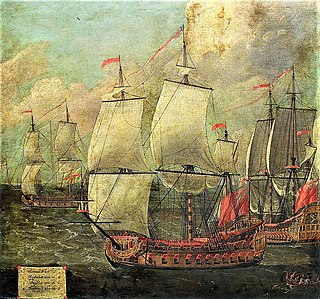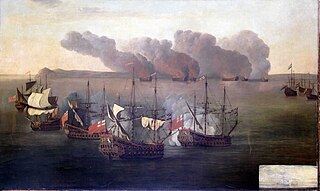HMS Ruby was a 40-gun frigate of the Commonwealth of England, built by Peter Pett at Deptford. She took part in actions during all three of the Anglo-Dutch Wars of 1652–1654, 1665–1667 and 1672–1674. She later served in the West Indies, and in 1683 was sent to the Leeward Islands to protect British settlements against Caribbean pirate raids. In 1687, the English pirate Joseph Bannister was captured by the crew of Ruby and brought to Port Royal for trial. She was rebuilt in 1687. She was captured by the French in October 1707.

Constant Warwick was a 32-gun privateer, built in 1645 as a private venture between the Earl of Warwick and Sir William Batten. Hired for service in the Parliamentarian navy during the First English Civil War, her captain William Batten defected to the Royalists during the 1648 Second English Civil War. After her crew mutinied in November 1648, she returned to England and was purchased by Parliament on 20 January 1649. Described as an "incomparable sailer", she was noted for her sharpness and fine lines, and is considered by some as the first true frigate of the Royal Navy. Mainly used for patrolling, she was captured by the French in 1691.

HMS Assurance was a 32-gun fourth-rate of the English Navy, built by Peter Pett I at Deptford Dockyard and launched in 1646. She was in the Parliamentary force during the English Civil War, then the Commonwealth Navy and was incorporated into the Royal Navy after the Restoration in 1660. During her time in the Commonwealth Navy she partook in the Battles of Dover, Portland, Gabbard and Texel. She foundered in a gale at Woolwich in 1660 and was salved. After the Restoration she partook in the Battle of Lowestoffe, the Four Days Fight and the Texel (1673). She was reduced to a Fifth Rate in 1690 before being sold in 1698.

HMS Adventure was a 34-gun fourth-rate of the English Navy, built by Peter Pett II at Woolwich Dockyard and launched in 1646. With the outbreak of the English Civil War she served on the Parliamentary side until 1649. She was incorporated into the Commonwealth Navy in 1650. She partook in the Battle off Dover in 1652, the Battle of Portland and the Battle of Gabbard in 1653. Adventure was employed on Bulstrode Whitelocke's embassy to Sweden, 1653–1654. After the Restoration she was incorporated into the Royal Navy. She was present at the Battle of Lowestoft (1665) and the Battle of Solebay (1672). She also participated in the Golden Horse and Two Lions actions in 1681. She was in the Battle of Barfleur in 1692. She captured several ships in the later part of her career, before being captured by the French in 1709.
Nonsuch was a 32-gun fourth-rate of the English Navy, built by Peter Pett I at Deptford Dockyard and launched in 1646. She was in the Parliamentary force during the English Civil War, then the Commonwealth Navy and was incorporated into the Royal Navy after the Restoration in 1660. During her time in the Commonwealth Navy she partook in the Battles of Krntish Knock, Portland and Gabbard. She was wreck at Gibraltar in 1664.

Elizabeth was a 38-gun fourth rate vessel of the Kingdom of England, Her initial commission was in the Parliamentary Naval Force during the English Civil War. During the Anglo-Dutch War she missed all the major Fleet actions. During the Second Anglo-Dutch War she participated in the St James Day Fight. She was burnt by the Dutch off Virginia in March 1667.
Sapphire was a 38-gun fourth-rate of the Commonwealth of England. After commissioning she was actively involved in the First Anglo-Dutch War participating in most major fleet actions. During the Second Anglo-Dutch War she was only in the first two engagements then spent her time in Irish Waters and the Mediterranean. She was run ashore due to a pending attack by suspected Algerian pirates on Sicily in March 1670.
HMS President was a 34-gun fourth-rate of the English Navy, built by Peter Pett I at Deptford Dockyard and launched in 1650. She was incorporated into the Commonwealth Navy in 1650. She partook in the Battle off Dover and Kentish Knock in 1652, the Battle of Portland, the Gabbard and Scheveningen in 1653. She was renamed Bonaventure in 1660. After the Restoration she was incorporated into the Royal Navy. She was present at the Battle of Lowestoft (1665), the Four Days Battle and the Oxfordness in 1666. She was rebuilt in 1666. She was present at the Battle of Martinique in 1667, Battle of Solebay (1672), Battle of Schooneveld and Texel in 1673, the Battle of Beachy Head in 1690, the Battle of Barfleur 1692.
The Pelican was one of six 40-gun fourth-rate frigates, built for the Commonwealth of England under the 1650 Programme. After commissioning she partook in the First Anglo-Dutch War being present at the Battles of Kentish Knock, Portland, the Gabbard and Scheveningen. She was accidentally burnt at Portsmouth in early 1656.

HMS Centurion was one of six 40-gun fourth-rate frigates, built for the Commonwealth of England under the 1650 Programme, she would be transferred to the navy of the Kingdom of England upon the Restoration of the monarchy in May 1660. When commissioned she partook in the First Anglo-Dutch War. After the first war ended she was in the Mediterranean fighting the Algerines at the Battle of Santa Cruz. She fought the battles of Dover, Portland, the Gabbard, and Scheveningen. During the Second Anglo-Dutch War she partook in the battles of Lowestoft and Orfordness. Following the second war she spent her time either in North America or the Mediterranean. She was wrecked in a storm in December 1689.

Foresight was a 40-gun fourth-rate of the Commonwealth of England, after the Restoration of the monarchy in 1660 she was incorporated into the Navy of the Kingdom of England. During her time in the Commonwealth Navy she partook in the First Anglo-Dutch war being present in the battles of Dungeness, Kentish Knock, Portland, The Gabbard and Scheveningen. She was also present at the Battle of Santa Cruz and the bombardment of Porto Farina, In the Second Anglo-Dutch War she was involved in the Battle of Vagen and the St James Day Fight. During the Third Anglo-Dutch War she participated in the battles of Schooneveld and Texel. For the remainder of her career she was in the West Indies, the Mediterranean and North American waters. She was wrecked south of Cuba in July 1698.
HMS Assistance was one of six 40-gun fourth-rate frigates, built for the Commonwealth of England under the 1650 Programme, after the Restoration of the monarchy in 1660 she was incorporated into the navy of the Kingdom of England. During her time in the Commonwealth Navy she partook in the First Anglo-Dutch war being present in the battles of Kentish Knock, Portland and The Gabbard. In the Mediterranean she was present at the Battle of Santa Cruz and the bombardment of Porto Farina, In the Second Anglo-Dutch War she was involved in the Battle of Lowestoft, Battle of Vagen and the St James Day Fight. She did not participate in fleet actions after this. She spent the rest of her service life undergoing several rebuilds and plying the waters as a cruiser protecting British trade and projecting British sovereignty. After nearly 95 years of Service she was sunk as a break water at Sheerness at the end of 1745.
Laurel was a 48-gun fourth-rate of the navy of the Commonwealth of England. She participated in almost all major Fleet Actions of the First Anglo-Dutch War. She was an active participant in the battles of Kentish Knock, Dungeness, Portland, The Gabbard and Scheveningen. She went to the west Indies with Admiral William Penn. She was wrecked in May 1657.
HMS Portsmouth was a 34-gun fourth-rate of the English Navy, built by Thomas Eastwood at Portsmouth Dockyard and launched in 1649. She was incorporated into the Commonwealth Navy in 1650. She partook in the Battle off Dover and Kentish Knock in 1652, the Gabbard and Scheveningen in 1653. After the Restoration she was incorporated into the Royal Navy. She was present at the Battle of Lowestoft (1665) and the Four Days Battle. She was present at the Texel in 1673, the Battle of Bantry Bay in 1689. She was captured by the French in August 1689 and blown up.
Expedition was a 30-gun pinnance in the service of the English Navy Royal. She spent her career in Home Waters. During the English Civil War she was employed in the Parliamentary Naval Force. In 1651 she was assigned to the Commonwealth Navy. She was in the Battle of Gabbard and Scheveningen in 1653. Upon the Restoration in 1660 she participated in the battles of Lowestoffe, Four Days' Fight and Orfordness in 1666. She was converted to a fireship then sold in 1667.
Providence was a 30-gun pinnance in the service of the English Navy Royal. She spent her career in Home Waters. During the English Civil War she was employed in the Parliamentary Naval Force. In 1551 she was assigned to the Commonwealth Navy. She was in the Battle of Gabbard. Upon the Restoration in 1660 she participated in the battles of Lowestoffe, Four Days' Fight and Orfordness in 1666. She was converted to a fireship then sold in 1667.
Guinea was a 38-gun fourth rate vessel of the Kingdom of England, Her initial commission was as a Royalist vessel during the English Civil War named Charles. She was captured then commissioned into the Parliamentary Naval Force as Guinea. During the First Anglo-Dutch War she partook in the Battle of Kentish Knock, the Battle of Portland and the Battle of The Gabbard. During the Second Anglo-Dutch War she participated in the Battle of Lowestoft, the Battle of Vagen and the St James Day Fight. She was sold on 27 November 1667.
Amity was a 36-gun fourth rate vessel of the Commonwealth of England. She was purchased by Parliament on 18 January 1650 and renamed. She was commissioned into the Parliamentary Naval Force as Amity. During the First Anglo-Dutch War she partook in the Battle of Portland and the Battle of The Gabbard. She was incorporated into the English Navy after the Restoration in May 1660. During the Second Anglo-Dutch War she participated in the Battle of Lowestoft, the Four Days' Battle and the St James Day Fight. She was sold on 27 November 1667.
Convertine was a 36-gun fourth rate vessel captured from the Portuguese by the Commonwealth of England. She was commissioned into the Parliamentary Naval Force as Convertine. During the First Anglo-Dutch War she partook in the Battle of Dungeness, Battle of Portland and the Battle of the Gabbard. During the Second Anglo-Dutch War she participated in the Battle of Lowestoft and the Four Days' Battle. She was captured during the Four Days' Battle.
The English ship Martin was a 14-gun sixth rate vessel built under the 1651 Programme at Portsmouth Dockyard for the Commonwealth of England in 1651/52. Her service in the Commonwealth Navy was very active. She participated in the Battles of Dover, Portland and the Gabbard. She was with Robert Blake at Porto Farina. She was the main vessel at the Capture of Jamaica in 1655. With the Restoration she became HMS Martin. During the Second Anglo-Dutch War she was in the initial battle of Lowestoft then the Battle of Vagen. She was sold in February 1667.



